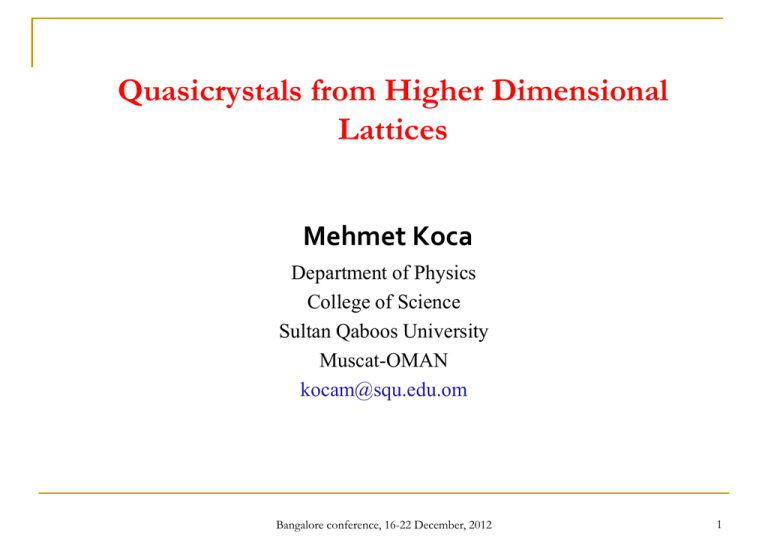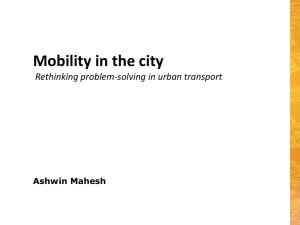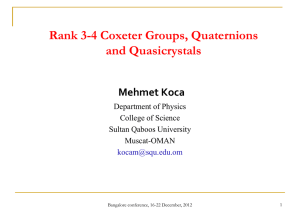Lecture 3
advertisement

Quasicrystals from Higher Dimensional
Lattices
Mehmet Koca
Department of Physics
College of Science
Sultan Qaboos University
Muscat-OMAN
kocam@squ.edu.om
Bangalore conference, 16-22 December, 2012
1
Crystallography
Modern crystallography started in 1912 with the seminal
work of von Laue who performed the first x-ray
diffraction experiment.
The crystals von Laue studied were ordered and periodic,
and all the hundreds of thousands crystals studied during
the 70 years from 1912 till 1982 were found to be
ordered and periodic.
Crystals are the 1D, 2D and 3D lattices invariant under
the translation and the rotational symmetries of orders
2,3,4,6.
In 2D and 3D translational invariance is not compatible
with rotations of orders such as 5, 7, 8, 10, 12, 30, 36.
Bangalore conference, 16-22 December, 2012
2
But in 1982 Daniel Shechtman has observed
a crystal structure in Al-Mn alloy displaying
10 fold symmetry not invariant under
translational symmetry.
Shechtman's is an interesting story, involving
a fierce battle against established science,
ridicule and mockery from colleagues and a
boss who found the finding so controversial,
he has been asked to leave the lab.
(Daniel Shechtman: Nobel
Prize in Chemistry, 2011),
Israel Institute of Technology
(Technion)
Bangalore conference, 16-22 December, 2012
3
A new definition for Crystal
“… By crystal we mean any solid having an
essentially discrete diffraction diagram, and by
aperiodic crystal we mean any crystal in which
three dimensional lattice periodicity can be
considered to be absent.”
Bangalore conference, 16-22 December, 2012
4
Electron diffraction from the Icosahedral
Phase has five-fold rotational axes and it
is not periodic.
The ratio of distances between the
central spot and other spots is the
Fibonacci Number τ known also as the
“Golden Mean”.
1 5
1.618
2
Bangalore conference, 16-22 December, 2012
5
Are QCs rare?
QCs are not rare there are hundreds of them
Bangalore conference, 16-22 December, 2012
6
Mathematical Modelling
Penrose Tiling of the plane
with 5-fold symmetry
Bangalore conference, 16-22 December, 2012
7
Penrose tiling can be obtained from the lattice B 5 and A4
by orthogonal projection technique
Affine A4 , Quaternions, and Decagonal Quasicrystals
Mehmet Kocaa), Nazife O. Kocab)
Department of Physics, College of Science, Sultan Qaboos University
P.O. Box 36, Al-Khoud, 123 Muscat, Sultanate of Oman
and
Ramazan Kocc)
Department of Physics, Gaziantep University, 27310, Gaziantep, Turkey
Bangalore conference, 16-22 December, 2012
8
The projected point set of the root lattice displays a generalized Penrose tiling
with a point dihedral symmetry D5 of order 10 which can be used for the
description of the decagonal quasicrystals.
The projection of the Voronoi cell of the root lattice of A4 describes a framework
of nested decagrams growing with the power of the golden ratio recently
discovered in the Islamic arts.
Note that the root and weight lattices of A3 correspond to the face centered cubic
(fcc) and body centered cubic (bcc) lattices respectively
Bangalore conference, 16-22 December, 2012
9
A3 Lattices
Root Lattice (FCC Lattice)
The root system of
(e1 e 2 ),(e 2 e3 ),(e3 e1 )
m11 m22 m33
Crystallography books use the generating vectors:
Weigh Lattice
e1 e 2 ,e 2 e3 ,e3 e1
a11 a22 a33 (a1 , a2 , a3 )
a1 2 1 0 m1
a 1 2 1 m
2
2 ,
a3 0 1 2 m 3
A3
The weight vectors i (i 1, 2,3)
m1
3 2 1 a1
1
m 2 4 2 a
2 4
2 .
m 3
1 2 3 a3
1
2
1
2
1 (e1 e 2 e 3 ), 2 e 3 , 3 (e1 e 2 e3 ) .
The primitive vectors of the bcc lattice in text books
1, 1 2 , 2 3
Bangalore conference, 16-22 December, 2012
10
Orbits of W(A3)
Tetrahedron: (1,0,0)A3
Octahedron :
(0,1,0)A3
Cube : (1,0,0)A3 +
(0,0,1)A3
Cuboctahedron :
(1,0,1)A3
Rhombic Dodecahedron
Wigner-Seitz Cell
Truncated Octahedron :
(1,1,1)A3
Wigner-Seitz Cell for
BCC
Bangalore conference, 16-22 December, 2012
11
Construction of the affine Coxeter group A4 in terms of
quaternions
0
1
2
3
4
Extended Coxeter-Dynkin diagram of
1 2 , 2
3 2e1 , 4
A4
1
(1 e1 e 2 e 3 ) ,
2
1
(e1 e 2 e 3 )
2
1 5
1 5
2
2 ,
W (A4 ) {[ p , cpc ] [ p ,cpc ]}
Bangalore conference, 16-22 December, 2012
12
1
( 5 e 2 e 3 ),
10
1
3
( 5e1 2e 2 2e 3 ),
10
1
(2 e 2 2 e 3 ),
10
1
2
4
(2e 2 2e 3 )
c,
10
5
1
H 1 2 3 4 1 4
( 1 e 2 e 3 )
2
Root Lattice: ( FCC in 4D)
1
2
m11 m 22 m33 m 44
Generalization of Rhombic Dodecahedron to 4D (WignerSeitz Cell in 4D)
(1,0,0,0)A4 (0,1,0,0)A4 (0,0,1,0)A4 (0,0,0,1) A4
Each Face is a rhombohedron
Weight Lattice (BCC in 4D)
a11 a22 a33 a44
Generalization of Truncated Octahedron to 4D:
(1,1,1,1)A4
Bangalore conference, 16-22 December, 2012
13
Orthogonal projection of the lattices onto the Coxeter plane and
the decagonal quasicrystallography
1
1
1
(1 3 ), 2
( 2 4 )
2
2
xˆ
x
1
(2 ) 2
1
(1 2 ), y
(1 2 )
2(2 )
2
[a1 a4 (a3 a2 )], y
2(2 )
[a1 +a 4 (a2 +a3 )]
Bangalore conference, 16-22 December, 2012
14
(a)
(b)
Projected 5-cells (a) the polytope
polytope (0,0,0,1)
(1,0,0,0)A4 and
A4
(a)
Projected polytopes (a)
(b) the
(b)
(0,0,1,0) A4 and
(b)
Bangalore conference, 16-22 December, 2012
(0,1,0,0) A4
15
The root system of A4 projected onto the Coxeter plane
(a) root system
(b) the polytope
The orthogonal projection of the Voronoi cell of the root lattice onto the Coxeter plane
(a) points
(b) dual of the polytope (1,0,0,1)
Bangalore conference, 16-22 December, 2012
16
Decagram point distributions
Bangalore conference, 16-22 December, 2012
17
Orthogonal projection of the polytope (1,1,1,1)A4
Bangalore conference, 16-22 December, 2012
18
Orthogonal projection of the polytope (0,1,1,0)A4
Bangalore conference, 16-22 December, 2012
19
Electron diffraction pattern of an icosahedral Ho-Mg-Zn
quasicrystal and A4 prediction
Bangalore conference, 16-22 December, 2012
20
Icosahedral symmetry
5
e1
1
e1 e2 e3 e2
2
The Coxeter diagram of H 3 with quaternionic simple roots
W (H 3 ) is a maximal subgroup of the group W (D6 )
D 6 lattices and their projections
Projection onto the Coxeter Plane
Let i be the simple roots
Let i be the weight vectors
(i , j ) ij , i , j 1, 2,...,6
Bangalore conference, 16-22 December, 2012
21
A general technique for every Coxeter-Weyl Group
Organize the generators of the Coxeter-Weyl group such that
R1 r1r3...rn 1 , R 2 r2r4 ...rn
ri commute with each other in each generator R i , i 1, 2 which
generate the Coxeter group I 2 (h ), h Coxeter number
Let
1 x i i , 2 x i i
i 1,3
i 2,4
be the generators of I 2 (h ) .
The coefficients x i are eigenvectors of the incidence matrix
(2I A )X cX , c=2cos
h
(largest eigenvalue)
Bangalore conference, 16-22 December, 2012
22
Define the generators of
I 2 (h ), (h 10) by
R1 r1r3r5r6 , R 2 r2 r4
The simple roots of I 2 (10)
1
1
(1 2 3 5 6 ), 2
2
1
( 2 4 )
2
A general vector of the weight lattice D 6
(a11 a22 a33 a44 a55 a66 ) (a1 , a2 , a3 , a4 , a5 , a6 ),
(ai Z, i 1, 2,..., 6)
Define the orthogonal unit vectors in the Coxeter plane
1
1
xˆ
( 1 2 ), yˆ
( 1 2 )
2(2 2)
2(2 2)
Components of the vector
x
y
(2 2 )
10
(2 2 )
10
(a1 ( 2 )a2 2a3 ( 2 )a4 a5 a6 ),
(a1 ( 2 )a2 2a3 ( 2 )a4 a5 a6 )
define the locations of the projected lattice points
Bangalore conference, 16-22 December, 2012
23
Some Examples
Bangalore conference, 16-22 December, 2012
24
Some Examples
(0,0,1,0,0,0)D6
(0,0,0,1,0,0)D6
Bangalore conference, 16-22 December, 2012
25
Some Examples
(0,0,0,0,1,0)D6
Bangalore conference, 16-22 December, 2012
(0,0,0,0,0,1)D6
26
Some Examples
(1,0,0,1,0,0)D6
(0,1,0,0,1,0)D6
Bangalore conference, 16-22 December, 2012
27
Some Examples
(1,1,1,1,1,1)D6
(0,0,1,0,1,0)D6
Bangalore conference, 16-22 December, 2012
28
Projection into 3D space of H3
R1 r3r6 , R 2 r2 r4 , R 3 r1r5
1
1
1
( 2 4 )
( l 3 l 4 l 5 l 6 )
2
2
1
1
2
( 3 6 )
(l 2 l 3 l 4 l 5 )
2
2
1
1
3
(1 5 )
(l 1 l 2 l 5 l 6 )
2
2
Bangalore conference, 16-22 December, 2012
29
Using
1
1 2e1 , 2
( e1 e 2 e 3 ), 3 2e 2
2
We obtain
l1 a (e 2 e 3 ), l 2 a (e 2 e 3 ), l 3 a (e 3 e1 ),
l 4 a (e 3 e1 ), l 5 a (e1 e 2 ), l 6 a (e1 e 2 ),
1
a
2(2 )
representing the vertices of an icosahedron
(1,0,0,0,0,0)D6 (0,0,1)H 3 Icosahedron(1)
Bangalore conference, 16-22 December, 2012
30
6D cube defined by the polytope
(0,0,0,0,0,1)B6 (0,0,0,0,1,0)D6 (0,0,0,0,0,1)D6
1
( l1 l 2 l 3 l 4 l 5 l 6 )(odd number of (-) sign)
2
1
( l1 l 2 l 3 l 4 l 5 l 6 )(even number of (-) sign)
2
(0, 0, 0, 0,1, 0) D6
(0, 0, 0, 0, 0,1) D6
Bangalore conference, 16-22 December, 2012
31
Projection of
(0, 0, 0, 0,1, 0) D 6 (1, 0, 0) H 3 (0, 0,1) H 3 Dodecahedron(1)+
Icosahedron(2)
Dodecahedron(1) {a ( e1 e 3 ), a ( e 2 e1 ), a ( e 3 e 2 ),
a ( e1 e 2 e 3 )}
Icosahedron(2)
{a ( e1 e 2 ), a ( e 2 e 3 ), a ( e 3 e1 )}
Bangalore conference, 16-22 December, 2012
32
Projection of
(0, 0, 0, 0, 0,1) D 6 (1, 0, 0) H 3 (0, 0,1) H 3 Dodecahedron(2)+
Icosahedron(3)
Dodecahedron(2) {a ( e1 e 3 ), a ( e 2 e1 ), a ( e 3 e 2 ),
a (e1 e 2 e 3 )}
Icosahedron(3)
{a ( e1 e 3 ), a ( e 2 e1 ), a ( e 3 e 2 )}
Bangalore conference, 16-22 December, 2012
33
A. Rhombic Triacontahedron
Icosahedron(2)+Dodecahedron(2)
B. Rhombic Triacontahedron
Icosahedron(1)+Dodecahedron(1)
Bangalore conference, 16-22 December, 2012
34
C. Icosahedron(3)+ Dodecahedron(1)
Bangalore conference, 16-22 December, 2012
35
Tiling three dimensional space with two
rhombohedra
Acute rhombohedron
Obtuse rhombohedron
Bangalore conference, 16-22 December, 2012
36
Conclusion
The projection technique developed can be applied
to any Coxeter group.
Projected points have the dihedral symmetry Dh of
order 2h.
Quasicrystals possessing a dihedral symmetry of
order 2h can be described by the appropriate
Coxeter group.
Bangalore conference, 16-22 December, 2012
37








